- Home
- About Journals
-
Information for Authors/ReviewersEditorial Policies
Publication Fee
Publication Cycle - Process Flowchart
Online Manuscript Submission and Tracking System
Publishing Ethics and Rectitude
Authorship
Author Benefits
Reviewer Guidelines
Guest Editor Guidelines
Peer Review Workflow
Quick Track Option
Copyediting Services
Bentham Open Membership
Bentham Open Advisory Board
Archiving Policies
Fabricating and Stating False Information
Post Publication Discussions and Corrections
Editorial Management
Advertise With Us
Funding Agencies
Rate List
Kudos
General FAQs
Special Fee Waivers and Discounts
- Contact
- Help
- About Us
- Search

The Open Electrical & Electronic Engineering Journal
(Discontinued)
ISSN: 1874-1290 ― Volume 13, 2019
Design of Rapid Energy-saving Intelligent Fast Charging Device
Zhang Lefang*, Li Xiaohong, Ren Zhihong
Abstract
As known that the traditional DC constant voltage charging equipment not only can cause the battery overcharge or insufficient charging, but also the charging time is too long. In the paper, based on the theory of pulse charging method and the design of the pulsed fast intelligent charging equipment is presented, the implementation of hardware and software process of the system is given out, the analysis of the results show that it can effectively prevent overcharge and low charge phenomenon in the charging process of battery.
Article Information
Identifiers and Pagination:
Year: 2016Volume: 10
First Page: 58
Last Page: 68
Publisher Id: TOEEJ-10-58
DOI: 10.2174/1874129001610010058
Article History:
Received Date: 9/3/2015Revision Received Date: 22/4/2015
Acceptance Date: 24/4/2015
Electronic publication date: 30/06/2016
Collection year: 2016
open-access license: This is an open access article licensed under the terms of the Creative Commons Attribution-Non-Commercial 4.0 International Public License (CC BY-NC 4.0) (https://creativecommons.org/licenses/by-nc/4.0/legalcode), which permits unrestricted, non-commercial use, distribution and reproduction in any medium, provided the work is properly cited.
Correspondence: Address correspondence to this author at the School of Information Engineering, Xi'an Eurasia University, 710065, Xi'an, China; Email: zlfka@163.com
| Open Peer Review Details | |||
|---|---|---|---|
| Manuscript submitted on 9-3-2015 |
Original Manuscript | Design of Rapid Energy-saving Intelligent Fast Charging Device | |
1. INTRODUCTION
From the research process of storage battery charging and discharging, the technology has a long process of development. In 1897, Peukert predicted the rate of discharge of the two various rate discharge, but he made little research and analysis in the field of charging. In 1935, woodbridge found that charging is sensitive to temperature and noticed that index characteristics of the battery. In 1967, Mars found the importance of deflated phenomena in the study, and started to apply this kind of phenomenon to the charging voltage control.
As people pay more attention to the problems of the charging, thus many charging devices are appeared, but most of these devices are made of analog circuit, the control effect is poor, debugging is complex, and the volume is larger. Until the 1990s, intelligent charge controller which involves integrates charge, discharge, detection and management was developed. Fast charging technology research got more and more attentions of many researchers in recent years, and it also achieved some good results, as the modified quick charger adopts digital control, which makes the work of debugging and maintenance of the charging system be reduced greatly, but most of these rapid charging technique are adopted the traditional control method and thoughts [1C. Alaoui, and Ziyad M. Salameh, "Experiments in fast charging lead acid electric vehicle batteries", In: Vehicular Technology Conference, 2003. VTC 2003-Fall. 2003 IEEE, 58th, vol. 5. IEEE: US, 2003, pp. 3326-3331.-3Y. Zhang, "The development of lead-acid battery technology", Auto Electrical Appliances, vol. 10, pp. 32-38, 2004.]. From several performance indicators of quick charge technology (i.e., charging the length of time, the efficiency of charging, the size of the temperature and the length of life), there are not ideal. In addition, in the charging technology and methods, there exists seriousenergy loss and waste.
2. DEVELOPMENT OF LEAD-ACID BATTERY CHARGING TECHNOLOGY
Pulse charging method not only can follow the inherent acceptance rate of the battery, and but also it can increase the rate of charging, thus break the limitation of the battery charging curve. It is also the new development of the battery charging theory. In the pulse charging way, first step is to use pulse current in the charging for the battery, and then stop the charging for a short time, then continue to charge. Pulse charging can make battery is full of power, in the break, the chemical combined reaction of oxygen and hydrogen can be absorbed, then the concentration polarization and ohm polarization naturally are eliminated, thus the battery internal pressure is reduced, the process can make the next round of constant current charging can more smoothly. The battery can absorb much more power and intermittent pulse makes the response time of the battery is long, reduce the output of the gas, and finally improve the battery charging current acceptance rate [4Y. Sun, Improving the performance of valve control type sealed lead-acid battery research., Master degree theses of master of Zheng Zhou university, China, 2001.-6L. Zhou, Electric vehicle battery charged life problem with adaptive control technology, vol. 14. Jiangsu bicycle, 2001, pp. 20-25.]. Several kinds of conventional charging methods are introduced as following:
2.1. Constant Voltage Charging
Constant voltage charging refers to each monomer battery is charged with a constant voltage. A constant voltage is generally selected as the single cell number multified with 2.4V, but in fact, the optimal value of this constant battery is varies with the structure and the life of the battery. The main characteristic of constant voltage charging are asearly charging current is quite big, battery terminal voltage and electrolyte relative density rise faster, with the continuation of charging, the charging current is gradually decreased, and in the charging end stage the charging current is small. If the current is properly selected, the charging process will be completed within eight hours, and charging process can be operated automatically, without human management [7C-C. Hua, and M-Y. Lin, "A study of charging control of lead-acid battery for electric vehicles. Industrial Electronics", Proceedings of the 2000 IEEE International Symposium, vol. 1, 2000 pp. 135-140 , 8D.A.J. Rand, L.S. Holden, G.J. May, R.H. Newnham, and K. Peters , "Valve-regulated lead/acid batteries", Journal of Power Sources, vol. 59, pp. 191-197.]. So the constant voltage charging are widely used in addition charge.
And in this methods there are a lot of insufficient: too much on the depth of discharge of the battery, will cause the initial charging current is too large, and cause damage to the battery; Can't adjust the size of the charging current, charging process does not apply to the early charging and charging to sulfur (sulfate). As shown in Fig. (1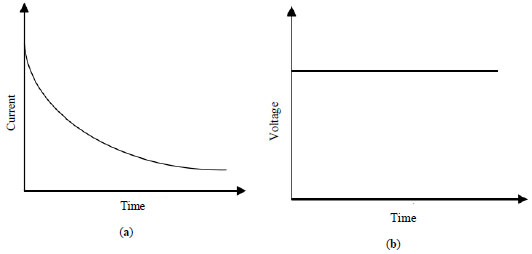 ), they are the typical performance of constant voltage charging curve:
), they are the typical performance of constant voltage charging curve:
 |
Fig. (1) Curve of the constant voltage charging method. |
2.2. Constant Current Charging
In a certain period of time, it use a constant current pass through the battery, its typical performance curve is as shown in Fig. (2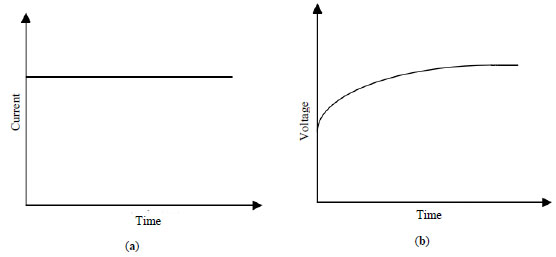 ).
).
 |
Fig. (2) Curve of the constant current charging method. |
The main features are as follwing, constant current charging method has strong adaptability, it can adjust the charging current, arbitrary choice and therefore it can be adopted under different conditions of charging, but when using this method, because the start charging current is too small, in the late charging process the charging current is too large, so the whole process will takes long time (generally need more than a dozen hours), but the separation of gas and the impact on the plate are large, energy consumption is also high, efficiency is low, and the whole process need specialist care.
2.3. Three Stages of Charging
So called three step, usually referes to constant current charging, when the battery's terminal voltage reaches a certain value, it will turn into the second stage, namely that the pressure limiting charging stage, when the charging current is small to some degree, it is the third stage, namely the trickle charging stage, its typical characteristics as shown in Fig. (3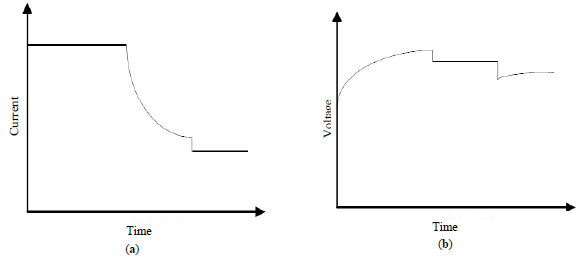 ).
).
Three stage charging can reduce outgassing rate to some extent, but the charging time is longer, the energy waste is serious, it also can't satisfied with the request of charging rapidity.
 |
Fig. (3) Curve of the three-step charging method. |
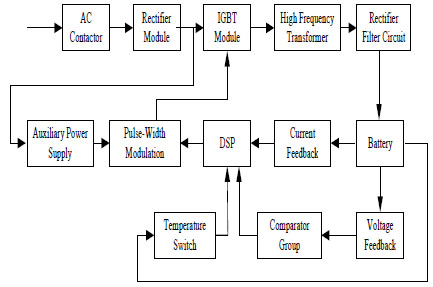 |
Fig. (4) The diagram of the system. |
2.4. Fast Charging Technology
In the 1970s, Mas (J.A.M AS) makes study of the current characteristic of battery charging, and proposed the Mas three laws which concerns on the history of discharge current, on the basis the researchers begin to studythe quick charge battery, and put forward the method of quick charge, pulse charging and reflection type charging method [9Hanhui Lu, "Battery charging management system key technology research", Master thesis., Shanghai Jiaotong university, China, 2007.-11M. Bernardi Dawn, R.Y Ying, and P. Watson, "Study of charge kinetics in valve-regulates lead-acid cells", J. Electrochem. Soc., vol. 151, no. 1, pp. 85-100, 2004.
[http://dx.doi.org/10.1149/1.1629098] ].
3. DESIGN OF THE PULSE CHARGING CIRCUIT
Charging system is mainly consists of two parts, the main circuit and control circuit, including: input rectifier module, IGBT, high-frequency transformer, rectifier filter circuit, TMS320LF2407DSP, pulse width chip, current sensor, voltage sensor, the comparator switches, temperature switches, DC auxiliary power supply, AC contactor and other parts of the system. The diagram is as shown in Fig. (4 ).
).
This device adopts the pulse charging circuit, it is the buck chopper circuit in essential, compared with the basic type of Buck DC - DC circuit, according to the actual requirement, the circuits of practical is worked in the continuous mode, in the design the inductance of the Buck circuit is get rid of, and we increase the power switch on the output side, and form the converter of charge pump type [12Wu Zhu, Qi Ding, W. Ma, Y. Gui, and H. Zhang, "Research on high frequency amplitude attenuation of electric fast transient generator", TELKOMNIKA Indonesian J. Elec. Eng., vol. 11, no. 1, 2013.
[http://dx.doi.org/10.11591/telkomnika.v11i1.1875] -15C Qing’an, Y. Zhang, C. Nan, and H. Liu, "SVR-based RPD approach for complex processes and its application in circuit optimization", TELKOMNIKA Indonesian J. Elec. Eng., vol. 11, no. 3, 2013.].
In this device, discharge resistances is removed, and use many energy storage capacitors instead, specific series can be set according to actual need, the fast charging device adopts two levels of energy storage capacitor. Two levels of energy storage capacitor through electronic parallel on both ends of battery in the beginning, its circuit structure are as shown in Fig. (5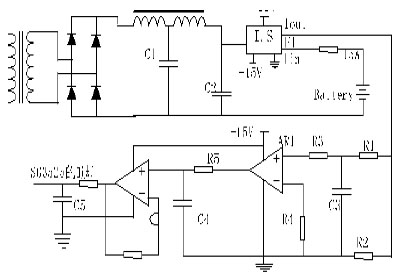 ), R3 and R4 are the equivalent resistance of the discharge capacitance circuit.
), R3 and R4 are the equivalent resistance of the discharge capacitance circuit.
 |
Fig. (5) Feedback circuit of the current. |
According to the specified fast charging method in the device and the specific requirements of the discharge power circuit module. The discharge circuit is as shown in Fig. (6 ).
).
As shown in Fig. (6 ), AC power pass through rectifier filter circuit to provide DC power for charging circuit, Q1,C2, Q2 forms the switch capacitor circuit of charging circuit, through control of the electronic switch DC power to realize the the energy storage capacitor charging and battery charging; And Q3 , Q4 ,Q5 ,Q6 form the switch capacitor discharge charge back road, through the power switch conduction alternately parallel discharge control to the battery energy storage capacitance C.
), AC power pass through rectifier filter circuit to provide DC power for charging circuit, Q1,C2, Q2 forms the switch capacitor circuit of charging circuit, through control of the electronic switch DC power to realize the the energy storage capacitor charging and battery charging; And Q3 , Q4 ,Q5 ,Q6 form the switch capacitor discharge charge back road, through the power switch conduction alternately parallel discharge control to the battery energy storage capacitance C.
3.1. Design of Pulse Charging Circuit
This device adopts the pulse charging circuit, essentially it is for Buck Chopper circuit, compared with the basic type of Buck DC-DC circuit, according to the requirement of the device, the practical circuit works in the continuous mode, in the BUCK circuit, the inductance can be get rid of, and increase the power switch on the output side, and form charge pump type Buck converter, as the effect of equivalent series resistance and the equivalent circuits of parallel resistance and will be equivalent to constant voltage source and the battery internal resistance in series, the actual structure and switching sequence control circuit are as shown in Fig. (7 ).
).
 |
Fig. (6) The circuit of charge and discharge. |
 |
Fig. (7) Structure and time sequence of charge circuit. |
3.2. Design of Discharge Energy Feedback Circuit
Just as mentioned above, in order to eliminate the polarization phenomenon of VRLA battery charged in the fast pulse charging, in order to improve the battery charge acceptance rate, fast charging method of this device combines the reflection type charging method, in the process of pulse charging, it join a certain discharge pulse, but in the reflection type charging method of fast charging, the discharge pulse energy consumption in the parallel resistance, as shown in Fig. (8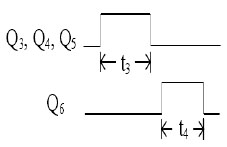 ), it can cause the waste of energy. In this device discharge resistance can be removed , and use for energy storage capacitor instead, specific series can be set according to actual need, the fast charging device adopts two levels of energy storage capacitor. Two levels of energy storage capacitor through electronic parallel on both ends of battery in the beginning, its circuit structure is as shown in Fig. (8
), it can cause the waste of energy. In this device discharge resistance can be removed , and use for energy storage capacitor instead, specific series can be set according to actual need, the fast charging device adopts two levels of energy storage capacitor. Two levels of energy storage capacitor through electronic parallel on both ends of battery in the beginning, its circuit structure is as shown in Fig. (8 ), the discharge capacitance circuit has equivalent series resistance.
), the discharge capacitance circuit has equivalent series resistance.
When the battery discharge trigger electronic switch guide to shunt capacitance discharge, the size of battery discharge current depends on the capacity of shun capacitance and parallel series. The duration of the discharge current depends on the shunt capacitance loop electronic switch conduction time, and is controlled by MCU. When through detecting the voltage on the external shunt capacitance, and it reaches a certain value, single-chip microcomputer control electronic switch shunt capacitance is converted into string model, in order to constitute a bootstrap circuit will increase capacitance voltage, and then power injection to the level of energy storage capacitor, realize the energy recovery of discharge current, thus to achieve the goal of energy saving. Sequence of Fig. (6 ) in each electronic switch conduction is as shown in Fig. (9
) in each electronic switch conduction is as shown in Fig. (9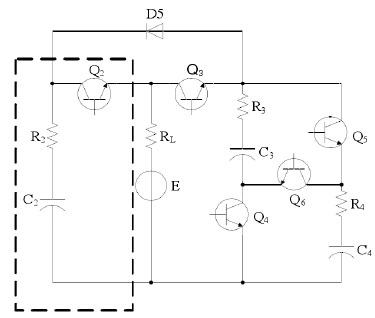 ).
).
 |
Fig. (8) Discharge energy feedback circuit. |
 |
Fig. (9) Electronic switch timing. |
4. CHARGING POWER SUPPLY ENERGY SAVING VALIDATION
In the device of the charging circuit, it simplifies the charger switch power supply structure, and new type of charging power structures to remove the high frequency pulse transformer and electronic switches, replace it with optically controlled PWM electronic switch, thus reduce the number of the energy dissipation element, lead the improvement of the power efficiency, it is a new type of power. In order to verify the battery DC power to get rid of the traditional switch power energy consumption such as the high frequency transformer, the experiment circuit diagram IS as shown in Fig. (10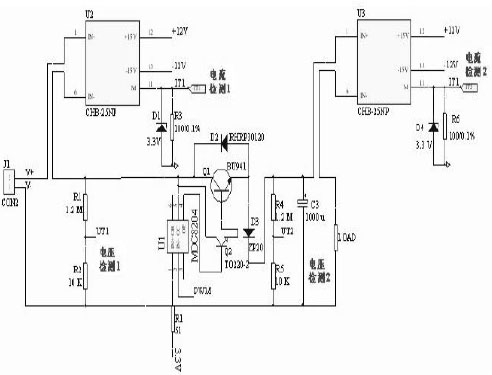 ), considering the security of experimental requirement etc, this experiment adopts DC 24V input as voltage regulation of PWM.
), considering the security of experimental requirement etc, this experiment adopts DC 24V input as voltage regulation of PWM.
 |
Fig. (10) The schematic diagram of energy transformation. |
As shown in Fig. (6 ), in a certain test time, the DC 24V power consumption and the consumption of electricity LOAD can be measured, through related comparisons, the energy conversion efficiency of the charging power supply can be obtained, in the actually implementation method, on the parts of UT1 and UT2, we test voltage value, on the parts of IT1 and IT2, the current values are detected, take the time t = 10ms as the sampling interval, after the time of 100 consecutive sampling, so the power energy conversion efficiency calculation formula is as (1).
), in a certain test time, the DC 24V power consumption and the consumption of electricity LOAD can be measured, through related comparisons, the energy conversion efficiency of the charging power supply can be obtained, in the actually implementation method, on the parts of UT1 and UT2, we test voltage value, on the parts of IT1 and IT2, the current values are detected, take the time t = 10ms as the sampling interval, after the time of 100 consecutive sampling, so the power energy conversion efficiency calculation formula is as (1).
 |
(1) |
Adjust frequency of PWM pulse is 200 Hz, the duty-ratio is 8%, the charging voltage is 5 V on both ends of the energy storage capacitor C3, high voltage is 24.8 V, the continuous sampling points are 100 points, the voltage and current can be calculated respectively:
The sum of low-end sampling the voltage and current value of the product:
 |
(2) |
 |
(3) |
According to the formula (2), power energy conversion efficiency can be calculated, and itis 97.62%. While the ordinary switch regulated power supply, energy conversion efficiency is only about 85%, even now the soft switch technology of DC/DC converter, its energy conversion efficiency only can reach 90%. In this system, the requirement of the power supply charge and discharge circuit, combined with the thought of energy saving, makes the power of energy conversion efficiency is improved by more than 7.62%, so the device can realize the design goal of saving energy in the new charging power supply.
As shown in Fig. (11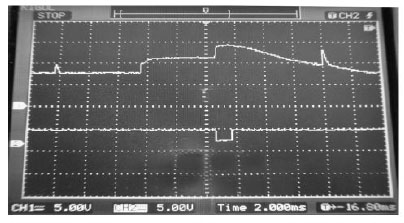 ), the measured waveform in CH1 is the feedback voltage point of waveform measured waveform in CH2 is the driving signal waveform for Q6, the front-end charge voltage is 13.0 V, on the energy storage capacitor C2, when Q6 is connected, the voltage feedback point voltage is 14.2V, the voltage can recharged to the energy storage capacitor C2. in the conduction cycle of Q6 , the absorption electric energy of C2 is:
), the measured waveform in CH1 is the feedback voltage point of waveform measured waveform in CH2 is the driving signal waveform for Q6, the front-end charge voltage is 13.0 V, on the energy storage capacitor C2, when Q6 is connected, the voltage feedback point voltage is 14.2V, the voltage can recharged to the energy storage capacitor C2. in the conduction cycle of Q6 , the absorption electric energy of C2 is:
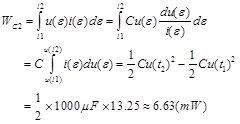 |
(4) |
5. PULSE CHARGING VOLTAGE CONTROL STRATEGY
The circuit adopts the voltage feedback control of the pulse fast charging technology, the charging parameters such as pulse frequency, duty cycle can be set flexible, in order to achieve the effect of different stages of charging, so as to achieve the optimal model of quick charging. Through changing electronic switch driven by main controller MCU, the charging pulse frequency and duty ratio effect can be changed.
As shown in the Figs. (11 -14
-14 ), when the drive signal is in low electricity, electronic switch is connected. In order to verify through setting the driving signal of duty ratio can change of the VRLA battery charging voltage and charging current, the circuit is designed as in Fig. (9
), when the drive signal is in low electricity, electronic switch is connected. In order to verify through setting the driving signal of duty ratio can change of the VRLA battery charging voltage and charging current, the circuit is designed as in Fig. (9 ).
).
 |
Fig. (11) The waveform of feedback voltage and drive signal. |
When the conduction cycle of Q2 and duty cycle are the constant, through adjusting the duty ratio of the Q1, and observe the voltage changes on charging capacitor C3, and the charge of voltage and charging current changes of Q2, so as to verify the feasibility of the fast charging strategies of pulsed control.
As shown in Fig. (7 ), the CHARGE + and CHARGE- are connected to the positive and negative at both ends of the battery, respectively. The filter capacitor C1 is 1000µF, voltage 450V, the power input terminal is access to AC48V and through rectification module KBPC5010 full bridge rectifier, the DC output is obtained, in the energy storage capacitor charging C3, we choose 1000µF and the 450 V electrolytic capacitor voltage. The conduction duty ratio of Q2 is 0.8, and we adjust conduction duty cycle of Q1 changes from 0.1 to 0.8, the mean peak voltage at the ends of the charging energy storage capacitor C3 and voltage, and the change of the average charging current flows through the battery can be observed just as shown in Table 1 and Fig. (15
), the CHARGE + and CHARGE- are connected to the positive and negative at both ends of the battery, respectively. The filter capacitor C1 is 1000µF, voltage 450V, the power input terminal is access to AC48V and through rectification module KBPC5010 full bridge rectifier, the DC output is obtained, in the energy storage capacitor charging C3, we choose 1000µF and the 450 V electrolytic capacitor voltage. The conduction duty ratio of Q2 is 0.8, and we adjust conduction duty cycle of Q1 changes from 0.1 to 0.8, the mean peak voltage at the ends of the charging energy storage capacitor C3 and voltage, and the change of the average charging current flows through the battery can be observed just as shown in Table 1 and Fig. (15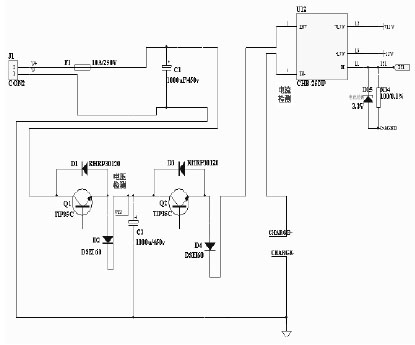 ).
).
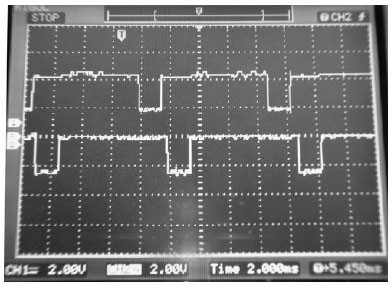 |
Fig. (12) Electronic switch drive signal timing waveforms. |
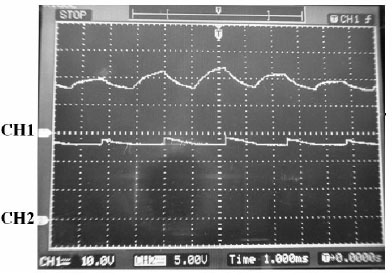 |
Fig. (13) The voltage waveform of charging capacitor and battery. |
 |
Fig. (14) VRLA voltage waveform. |
 |
Fig. (15) The circuit of charging Policy Verification. |
CONCLUSION
From the study, we can find that the pulsed charging device performance battery is excellent; it can greatly reducing the battery charging time and improve the real-time application performance of the battery. Because the depolarization pulse can eliminate the overcharging of the battery, and effectively ensure the service life of the battery, at the same time we use the front-end rectifier part switch power supply to replace traditional rectifier device, it greatly reduce the volume and weight of the device. Pulsed fast charging device thus greatly reduce its volume and weight of the device, pulse fast charging device developed has a broad application prospect.
CONFLICT OF INTEREST
The authors confirm that this article content has no conflict of interest.
ACKNOWLEDGEMENTS
Declared none.
REFERENCES
| [1] | C. Alaoui, and Ziyad M. Salameh, "Experiments in fast charging lead acid electric vehicle batteries", In: Vehicular Technology Conference, 2003. VTC 2003-Fall. 2003 IEEE, 58th, vol. 5. IEEE: US, 2003, pp. 3326-3331. |
| [2] | J. Marcos, J. Dios, A.M. Cao, J. Doval, C.M. Penalver, A. Nogueiras, A. Lago, and F. Poza, "Fast lead-acid battery charge strategy", In: Twenty-First Annual IEEE Applied Power Electronics Conference and Exposition, 2006. APEC '06., vol. 4. IEEE: Dallas, TX, 2006, pp. 19-23. |
| [3] | Y. Zhang, "The development of lead-acid battery technology", Auto Electrical Appliances, vol. 10, pp. 32-38, 2004. |
| [4] | Y. Sun, Improving the performance of valve control type sealed lead-acid battery research., Master degree theses of master of Zheng Zhou university, China, 2001. |
| [5] | R.H. Sparks, "Rapid Charging Batteries For Electric Proplusion Systems", SAE paper, no. 1, 1972. |
| [6] | L. Zhou, Electric vehicle battery charged life problem with adaptive control technology, vol. 14. Jiangsu bicycle, 2001, pp. 20-25. |
| [7] | C-C. Hua, and M-Y. Lin, "A study of charging control of lead-acid battery for electric vehicles. Industrial Electronics", Proceedings of the 2000 IEEE International Symposium, vol. 1, 2000 pp. 135-140 |
| [8] | D.A.J. Rand, L.S. Holden, G.J. May, R.H. Newnham, and K. Peters , "Valve-regulated lead/acid batteries", Journal of Power Sources, vol. 59, pp. 191-197. |
| [9] | Hanhui Lu, "Battery charging management system key technology research", Master thesis., Shanghai Jiaotong university, China, 2007. |
| [10] | A. Kirchev, D. Pavlov, and B. Monahov, "Gas-diffusion approach to the kinetics of oxygen recombination in lead-acid batteries", J. Power Sources, vol. 113, no. 2, pp. 245-254, 2003. [http://dx.doi.org/10.1016/S0378-7753(02)00520-7] |
| [11] | M. Bernardi Dawn, R.Y Ying, and P. Watson, "Study of charge kinetics in valve-regulates lead-acid cells", J. Electrochem. Soc., vol. 151, no. 1, pp. 85-100, 2004. [http://dx.doi.org/10.1149/1.1629098] |
| [12] | Wu Zhu, Qi Ding, W. Ma, Y. Gui, and H. Zhang, "Research on high frequency amplitude attenuation of electric fast transient generator", TELKOMNIKA Indonesian J. Elec. Eng., vol. 11, no. 1, 2013. [http://dx.doi.org/10.11591/telkomnika.v11i1.1875] |
| [13] | T. Wu, C. Quan, L. Liu, X. Qing, and X. Wang, "Research on the fast charging of VRLA", TELKOMNIKA Indonesian J. Elec. Eng., vol. 10, no. 7, 2012. |
| [14] | M. Tian, Y. hong, and D. Yuan, "Research on coordinate transformation of the three-phase circuit", TELKOMNIKA Indonesian J. Elec. Eng., vol. 11, no. 8, 2013. |
| [15] | C Qing’an, Y. Zhang, C. Nan, and H. Liu, "SVR-based RPD approach for complex processes and its application in circuit optimization", TELKOMNIKA Indonesian J. Elec. Eng., vol. 11, no. 3, 2013. |




